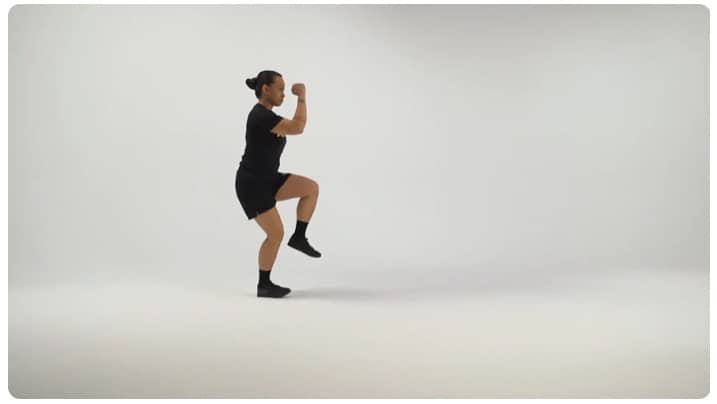
Military Movement Drill 2 (MMD2) is a series of exercises in the sustaining phase designed to enhance running form, dynamically prepare the body for more vigorous running activities, and develop motor efficiency.
- It’s conducted following certain preparatory exercises and prior to running activities during a Physical Readiness Training (PRT) session.
- Army MMD2 contains three dynamic, plyometric exercises and should be performed in a specified manner, similar to its counterpart, MMD1.
- The drill ensures that soldiers are well-equipped with the necessary movement skills and physical capabilities for more challenging military tasks.
Table of Contents
show
Military Movement Drill 2 (MMD2)
The Military Movement Drill has three exercises:
- Exercise 1: Power Skip
- Exercise 2: Crossovers
- Exercise 3: Crouch Run
Purpose:
- Enhance running form.
- Dynamically prepare the body for intense running activities.
- Foster motor efficiency.
Execution:
- Phase: Conducted in the sustaining phase.
- Sequence: Follows preparation and the HSD. Done before running activities in a PRT session.
- Composition: Consists of three dynamic, plyometric exercises.
- Note: Always perform in the same manner as MMD1.
Military Movement Drill 2 Ordering:
- If both MMD1 and MMD2 are performed, MMD1 should precede MMD2.
- Caution: Do not interchange exercises between the two drills. Always perform as prescribed in this FM.
Army MMD2 Conditions:
- The MMD2 serves as a dynamic preparation for plyometric activities needed in Conditioning Drill 3, obstacle course negotiation, Terrain Runs, and other multi-planar movements found in combat tasks.
- The soldier will be provided with:
- A PRT area with traffic cones set as per ATP 7-22.02
- An approved PRT plan.
- A designated PRT.
- During the scheduled unit PRT, the PRT instructor specifies a uniform.
- Standard MOPP 4 conditions are not applicable.
Military Movement Drill 2 Standards:
- The objective is to execute Military Movement Drill 2, incorporating all prescribed exercises as laid out in the plan.
- Every exercise must be executed in the given sequence and performed accurately, as described.
- It’s imperative to ensure the exercises are performed without causing harm or making mistakes.
- Adherence to the GO and NO-GO criteria, the approved PRT plan, and ATP 7-22.02, “Holistic Health and Fitness Drills and Exercises,” is mandatory.
Special Conditions:
- None
Safety Risk:
- Low
MOPP 4:
- N/A
In essence, the Army MMD2 is structured to prepare soldiers for various combat-related physical movements.
- The set conditions, standards, and safety measures ensure that the drill is both effective and safe for all participants.
Army MMD2
Army MMD2 has three exercises:
- Exercise 1: Power Skip
- Exercise 2: Crossovers
- Exercise 3: Crouch Run
Power Skip
- Purpose: The Power Skip is designed to increase lower limb power and enhance coordination between the arms and legs.
- This exercise simulates the explosive movements required during rapid advancements on the field.
Muscles Worked:
- Quadriceps: These are the primary muscles on the front of the thigh responsible for extending the knee.
- Hamstrings: Located at the back of the thigh, they are involved in knee flexion and hip extension.
- Glutes (Buttocks): These muscles aid in propelling the body upwards.
- Calves (Gastrocnemius and Soleus): Aid in the push-off from the ground.
- Hip Flexors: Engage when driving the knee upwards.
- Deltoids and Arm Muscles: Assist in the coordinated swinging of the arms.
Benefits:
- Improved Lower Limb Power: Enhances the ability to generate force quickly.
- Coordination: Develops coordination between the arms and legs.
- Proprioception: Improves body awareness in space, beneficial for agile movements.
Crossovers
- Purpose: Crossovers work on lateral movement and flexibility of the hips.
- This exercise helps in situations where soldiers need to move sideways, such as navigating through obstacles or changing directions quickly in response to threats.
Muscles Worked:
- Hip abductors (especially Gluteus Medius and Minimus): Engaged during the sideways movement to stabilize the pelvis and move the leg sideways.
- Hip adductors: Inner thigh muscles that pull the leg inwards during the crossover step.
- Core muscles (including the obliques): Stabilize the body during the lateral motion.
- Deltoids: Engaged when arms are raised for balance.
Benefits:
- Lateral Movement Efficiency: Increases proficiency in side-to-side movements.
- Hip Flexibility: Enhances the range of motion in the hips, beneficial for agility.
- Balance and Stability: Improves the ability to maintain balance during multidirectional movements.
Crouch Run
- Purpose: The Crouch Run develops lower body strength and the ability to move rapidly while staying low to the ground, which can be crucial for evading threats or moving under obstacles.
Muscles Worked:
- Quadriceps: Engaged to keep the body in a crouched position.
- Hamstrings and Glutes: Help in propelling the body forward from a low position.
- Calves: Aid in the push-off during the run.
- Core Muscles: Engaged to stabilize the body and maintain the crouch posture.
Benefits:
- Lower Body Strength: Enhances strength, especially in the quads, from maintaining a crouched position.
- Agility: Improves the ability to move quickly from a low position, which is crucial in situations like evading threats.
- Endurance: The constant engagement of muscles builds muscular endurance, which is beneficial for prolonged activities.
Conclusion
In conclusion, the exercises within Military Movement Drill 2 not only promote strength, flexibility, and coordination but also simulate essential battlefield movements, ensuring soldiers are both physically and functionally prepared.
Military Movement Drill 2 (MMD 2)
- Exercise 1: Power Skip
- Exercise 2: Crossovers
- Exercise 3: Crouch Run
Latest posts by George N. (see all)
- Empowering Transactions: Navigating Firearms Sales with Proper Documentation - April 8, 2024
- Army PRT – Preparation and Recovery 2024 - March 18, 2024
- Active and Reserve Components 2024 - March 6, 2024
